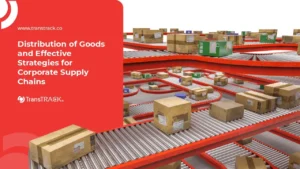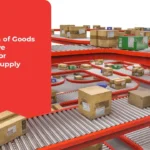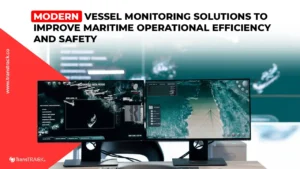Definition of Port of Loading and its Important Role in International Trade
Posted on January 25, 2024 by Nur Wachda Mihmidati

Ports of loading, or ports of call, play an important role in the international trade supply chain. Port of loading is the port where goods are loaded onto ships for export. Choosing the right port of loading greatly affects the smoothness and efficiency of cross-border trade logistics.
How to choose the right port of loading? What are the functions of the ports of call? Let’s find out the answers in the following article TransTRACK. In this article, we will explore the meaning of port of loading, its main functions, and the crucial factors in ports of call selection.
Definition of Port of Loading
Port of Loading has a very important role in international trade activities by sea. Port of loading is a seaport facility where goods begin to be loaded onto ships for export to the destination country. This is usually stated in the Letter of Credit (L/C) document or sales contract.
By definition, a ports of call can be defined as a port in a country where containers or bulk goods are loaded from a warehouse, container freight station, or freight yard onto a sea vessel, usually a container ship or bulk carrier.
Port of loading is not the same as port of discharge or port of destination. Port of discharge is the port in the destination country where the goods are unloaded. Meanwhile, port of destination refers to the final port in the buyer’s country where the ship calls at.
Functions of Port of Loading
Port of loading has several vital functions in supporting the smooth flow of international trade logistics. Broadly speaking, the functions of the ports of call include:
Place of Receipt and Storage of Export Goods
Before being loaded onto a ship, export goods are usually first shipped from the factory or warehouse to the port as the ports of call. These goods are then temporarily stored in warehouses or open storage yards provided in the port area.
This storage is needed to match the ship’s arrival schedule that has been set beforehand. Usually, goods are stored for several days to a week before the ship docks and loading takes place. The existence of warehouse and storage facilities allows the loading port to receive export goods on a large scale before they are gradually distributed to the ships.
Goods to Container Stuffing Facility
Stuffing is the process of moving goods from a warehouse or stacking yard into a container using a reach stacker, forklift or conveyor. The goal is to get the goods ready to be shipped via containerization. The loading port area is also usually equipped with a Container Freight Station (CFS). CFS serves as a place for stuffing or packing goods into containers before they are shipped using ships.
At the CFS, consolidated goods from several exporters are arranged and arranged in such a way into 20 or 40 feet containers so that the utilization of container space is optimal. CFS facilitates the process of stuffing containers without disrupting other activities at the port container terminal.
Export Documentation Place
Before the goods are physically loaded onto the ship, export documentation must first be completed. Documents such as the Notice of Export of Goods (PEB), Invoice, Packing List, Bill of Lading (B/L) are usually taken care of at the Customs office in the loading port area. The processing of these documents must be done in accordance with applicable customs and international trade procedures.
Loading Goods onto the Ship
The core function of a ports of call is where goods are loaded onto the vessel that will take them to their final destination. It involves strict coordination between interested parties, including shipping agents, terminal parties, and ship captains. The loaded goods must be carefully organized to ensure stability and safety during the sea voyage.
The loading of goods onto the ship must also be in accordance with the established schedule and shipment plan. The process of moving containers from the dock to the ship usually uses a quay crane or a special containerized rubber tyred gantry crane to facilitate the process.
Port of Loading Selection Factors
In determining the port of loading, there are at least several important factors that exporters and importers need to consider, including:
Location and Accessibility
The geographical location of the port of loading plays a central role in the selection decision. Ports that are close to the final destination can reduce travel time and inland transportation costs once the goods arrive at the port. Ports that are easily accessible by major shipping lanes also allow for more direct and efficient routes.
Infrastructure and Facilities
The quality of infrastructure and facilities at a port can affect operational efficiency. The presence of modern and sophisticated loading and unloading facilities can speed up the shipping process and reduce the time for ships to dock. Ports equipped with a good container handling system are also an important consideration to improve efficiency in transferring goods from ships to land vehicles or vice versa.
Regulation and Compliance
Regulatory factors and compliance with international standards can have a significant impact on the smooth process of international trade. Ports that understand and comply with customs regulations and import-export regulations can avoid unwanted administrative obstacles.
In international trade, a port of loading is not just a place where goods are loaded onto ships, but a vital node in the global supply chain.
In addition to understanding the conventional aspects of loading ports, it is also important to understand how technology can improve the international trade process. One solution that you can do is to use a Transportation Management System (TMS).
TMS is a technology platform that automates and manages various aspects of logistics and transportation. The system offers various advantages that can enhance international trade ranging from route and delivery time optimization, real-time tracking, to documentation automation.
By combining knowledge of port of loading functions and technological advancements such as TMS, you can increase your competitiveness in a competitive global market. Interested in adopting this TMS technology? Just contact TransTRACK right now!
Recent Post
Topic :
Recommended Articles

 Bahasa Indonesia
Bahasa Indonesia







